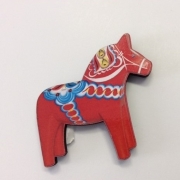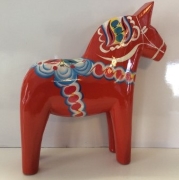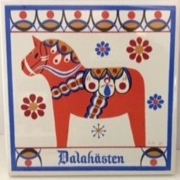   |
THE STORY OF THE DALA HORSE |
The traditional symbol of Sweden is the Dalahast, or Dala Horse. Since Viking times, the horse was considered a treasured animal. A horse represented a creature of great value, a tower of strength in helping the family. It was a faithful friend who drew loads in the forest during winter, worked in the fields and meadows in spring and summer and carried equipment up to the delightful summer pastures and adjoining chalets of Scandinavia. Horses also provided transportation between villages and parishes and trips to the mill and to the market. There was so much pleasure with having a horse. Children really enjoyed their company. They could ride bareback, and many children were able to sit on its broad strong back at the same time. Carved wooden horses were plain and made as children’s toys. The Dala horse symbol originated during the 18th century in the Dalarna region of Sweden. Legend is that a hungry soldier came to Dalarna and he carved a horse from a piece of a tree. Then he took red clay, and mixed it with water to paint the horse. When it was finished, he gave it to a young boy who had been watching him. The child was so excited with the gift that he took the soldier and the wooden horse home to show his mother. In return for the kindness shown to her son, the mother gave the soldier a bowl of soup. In the 17th century, the hand carved Dala horses were also sometimes used as payment for board and lodging. During the long winter months or in times of poor crops, it was necessary to augment income with revenues from other sources. The men would fill a wagon with brightly colored horses and other homemade articles. They would venture out to sell or barter for grain. To show their appreciation for overnight accommodations at farmhouses along the way, they would offer painted horses for the children, and they became treasured toys. These wooden horses came originally from the Mora villages of Vattnas, Rise, Bergkalas and Nusnas. Tinkers traveled about the country to sell products of the cottage industry. Their wares were baskets, grinding stones and wooden casks. Often they took Dala horses to add to their collection of goods. During the 19th century, it became the custom to paint the wooden horses with richly colored flower patterns like the Dala painting that decorated furniture and interior walls. The Dala horses appeared with the traditional Swedish folk art red color with kurbits (a big plant, with gourds and leaves) and flowers covering the saddle. The designs come from the Biblical story of Jonah. He sat outside Ninevah, and the Lord caused a kurbit of gourd vine to grow, protecting him from the desert sun. In current times, nine people are involved in the making of one horse from the Nusnas factory. Dala horses are made in many sizes, from less than half an inch up to 60 inches (or five feet), and they are available in a variety of different colors and patterns. Here at The Wooden Spoon we have all colors, shapes and sizes of Dala Horses! Check out our wooden horses sitting or standing, painted on ceramic tile, serving dishes, regular and travel mugs, wine glasses, snapps glasses, wooden spreaders, decals or magnets, or they can be found in wood or silver as necklaces or earrings. We have books on Dala horses, Dala horse key rings, cookie cutters, stencils, stamps, labels, Christmas cards, wooden ornaments, lapel pins, tablecloths, dish cloths, napkins, and paper pull-outs! We even have Dala socks! Visit and see for yourself. Swedish people believe that if you don't like how things are going in life, change the direction of your Dala horse(s). And if you need to ward off evil, place your Dala horse with its hind legs towards the door, ready to kick the bad spirits away! |
Gwen Welk Workman, February 2, 2002 |
The Story of the Dala Horse
August 13th 2020 - Writings

Comments